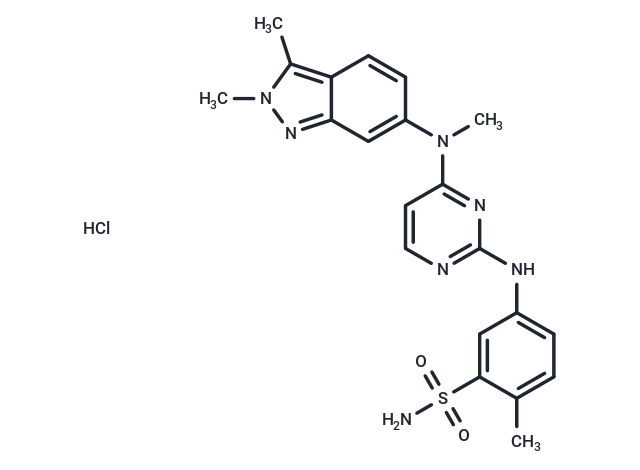Shopping Cart
- Remove All
 Your shopping cart is currently empty
Your shopping cart is currently empty

Pazopanib Hydrochloride (Votrient HCl) is a novel multi-target inhibitor of VEGFR1, VEGFR2, VEGFR3, PDGFR, FGFR, c-Kit and c-Fms with IC50 of 10 nM, 30 nM, 47 nM, 84 nM, 74 nM, 140 nM and 146 nM in cell-free assays, respectively.

| Pack Size | Price | Availability | Quantity |
|---|---|---|---|
| 10 mg | $48 | In Stock | |
| 25 mg | $83 | In Stock | |
| 50 mg | $97 | In Stock | |
| 100 mg | $143 | In Stock | |
| 200 mg | $240 | In Stock | |
| 500 mg | $378 | In Stock | |
| 1 mL x 10 mM (in DMSO) | $48 | In Stock |
| Description | Pazopanib Hydrochloride (Votrient HCl) is a novel multi-target inhibitor of VEGFR1, VEGFR2, VEGFR3, PDGFR, FGFR, c-Kit and c-Fms with IC50 of 10 nM, 30 nM, 47 nM, 84 nM, 74 nM, 140 nM and 146 nM in cell-free assays, respectively. |
| Targets&IC50 | VEGFR2:30 nM, FGFR:74 nM, VEGFR3:47 nM, c-Fms:146 nM, VEGFR1:10 nM, PDGFR:84 nM, c-Kit:140 nM |
| In vitro | Pazopanib potently inhibits VEGF-induced phosphorylation of VEGFR2 in HUVEC cells with IC50 of 8 nM. [1] Pazopanib shows dose-dependent growth inhibition in all synovial sarcoma cell lines including SYO-1 and HS-SY-II cells. Proliferation of SYO-1 and HS-SY-II cells is inhibited even at 1?μg/mL of Pazopanib and is completely abolished at 5?μg/mL. Pazopanib induces G1 arrest, and thereby suppresses the growth of synovial sarcoma cells. Phosphorylation of Akts, GSK-3β, JNKs, p70 S6 Kinase, and mTOR is suppressed in Pazopanib-treated SYO-1 cells compared with that in the vehicle-treated cells. [2] Pazopanib between 20 m g/mL and 22.5 m g/mL shows an increasing reduction of RPE cell viability. [3] |
| In vivo | The mice treated with 30 mg/kg or 100?mg/kg Pazopanib reveals a significant decrease in tumor burden compared with the mice treated with vehicle or 10?mg/kg Pazopanib. Treatment with Pazopanib is well-tolerated and there is no significant difference in the body weight among the mice in each group. [2] |
| Kinase Assay | Kinase enzyme assays: VEGFR enzyme assays for VEGGR1, VEGFR2, and VEGFR3 are run in homogeneous time-resolved fluorescence (HTRF) format in 384-well microtiter plates using a purified, baculovirus-expressed glutathione-S-transferase (GST) fusion protein encoding the catalytic c-terminus of human VEGFR receptor kinases 1, 2, or 3. Reactions are initiated by the addition of 10 μL of activated VEGFR2 kinase solution [final concentration, 1 nM enzyme in 0.1 M HEPES, pH 7.5, containing 0.1 mg/mL bovine serum albumin (BSA), 300 μM dithiothreitol (DTT)] to 10 μL substrate solution [final concentration, 360 nM peptide, (biotin-aminohexyl-EEEEYFELVAKKKK-NH2), 75 μM ATP, 10 μM MgCl2], and 1 μL of titrated Pazopanib in DMSO. Plates are incubated at room temperature for 60 min, and then the reaction is quenched by the addition of 20 μL of 100 mM ethylene diamine tetraacetic acid (EDTA). After quenching, 20 μL HTRF reagents (final concentration, 15 nM Streptavidin-linked allophycocyanin, 1 nM Europium-labeled antiphosphotyrosine antibody diluted in 0.1 mg/mL BSA, 0.1 M HEPES, pH 7.5) is added and the plates incubated for a minimum of 10 min. The fluorescence at 665 nM is measured with a Wallac Victor plate reader using a time delay of 50 μs. |
| Cell Research | Phosphorylation of VEGFR2 is assessed in HUVEC stimulated with VEGF. HUVEC are plated in type-I collagen-coated 10 cm plates in Clonetics EGM-MV medium at 1.0-1.5 × 106 cells/plate. After 24 hours, the confluent cells are serum starved overnight by replacing the growth medium with Clonetics EBM medium containing 0.1% BSA, 500 μg/mL hydrocortisone. Cells are treated with Pazopanib at various concentrations for 1 hour, followed by addition of 10 ng/mL VEGF or vehicle for 10 min. Cells are solubilized in lysis buffer. VEGFR2 is immunoprecipitated using antiflk-1 antibody and analyzed by sodium dodecyl sulfate polyacrylamide gel electrophoresis (SDS-PAGE) followed by Western blotting and detection with antiflk-1 or with antiphosphotyrosine (anti-P-tyr-biotin) antibody. The VEGFR2 phosphorylation level is quantified by densitometry and normalized to the total VEGFR2 level. (Only for Reference) |
| Alias | Votrient HCl, Pazopanib HCl, GW786034 HCl |
| Molecular Weight | 473.98 |
| Formula | C21H23N7O2S·HCl |
| Cas No. | 635702-64-6 |
| Smiles | Cl.CN(C1=CC2=NN(C)C(C)=C2C=C1)C1=NC(NC2=CC=C(C)C(=C2)S(N)(=O)=O)=NC=C1 |
| Relative Density. | no data available |
| Storage | Powder: -20°C for 3 years | In solvent: -80°C for 1 year | Shipping with blue ice. | ||||||||||||||||||||
| Solubility Information | H2O: < 1 mg/mL (insoluble or slightly soluble) Ethanol: < 1 mg/mL (insoluble or slightly soluble) DMSO: 7.5 mg/mL (15.82 mM), Sonication is recommended. | ||||||||||||||||||||
Solution Preparation Table | |||||||||||||||||||||
DMSO
| |||||||||||||||||||||

Copyright © 2015-2025 TargetMol Chemicals Inc. All Rights Reserved.